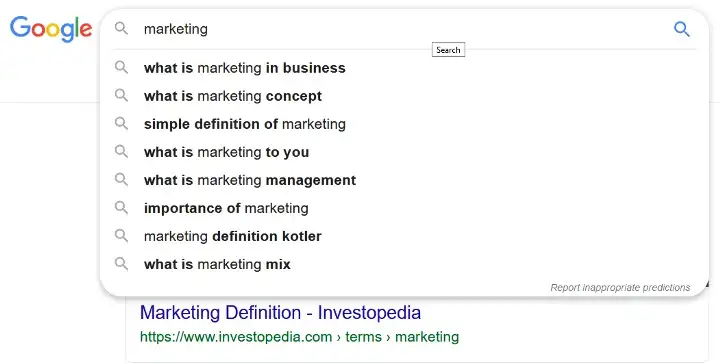
Introduction
- Definition of SEO: SEO stands for Search Engine Optimization, which is the process of optimizing a website to improve its visibility and ranking on search engine results pages (SERPs). This is done by improving the website's relevance and authority, as well as making it more user-friendly.
- Importance of SEO in digital marketing: SEO is a crucial component of digital marketing as it helps to improve the visibility and ranking of a website on search engines. This can lead to increased website traffic, higher conversion rates, and ultimately, more revenue for a business.

Image Source: Medium SEO
On-page SEO
- Title tags and meta descriptions: Title tags and meta descriptions are HTML elements that provide information about a web page's content to search engines. Title tags tell search engines what the page is about, while meta descriptions provide a summary of the page's content. Optimizing these elements can help to improve the visibility and click-through rate of a website on search engine results pages.
- Content optimization: Content optimization involves creating high-quality, relevant, and keyword-rich content that is optimized for both search engines and users. This includes using target keywords in headlines, subheadings, and throughout the body of the content.
- URL structure: A well-structured URL makes it easier for search engines to understand the content of a web page and can also make it more user-friendly. URLs should be short, descriptive, and include target keywords.
- Header tags: Header tags (H1, H2, H3, etc.) are used to structure the content of a web page and indicate the hierarchy of information. Search engines use these tags to understand the content of a page and can help to improve the visibility of a website on search engine results pages.
- Image optimization: Images can slow down a website's loading time, which can negatively impact its visibility and ranking on search engine results pages. Optimizing images by compressing them and using relevant, keyword-rich file names can help to improve a website's speed and visibility on search engines.
- Internal linking: Internal linking is the process of linking to other pages on a website from within the site's content. This can help to improve the visibility and ranking of a website on search engine results pages, as well as make it more user-friendly.
.jpg)
Off-page SEO
- Backlinks: Backlinks are links that point to a website from other sites. Search engines use these links to determine the authority and relevance of a website, and a higher number of high-quality backlinks can improve a website's visibility and ranking on search engine results pages.
- Social media: Social media can be used to drive traffic to a website, as well as help to improve its visibility and ranking on search engine results pages. This can be done by sharing links to the website on social media, as well as optimizing social media profiles for search engines.
- Local SEO: Local SEO is the process of optimizing a website for local search results. This includes optimizing for local keywords, creating local business listings, and encouraging customers to leave reviews.
- Directory submissions: Submitting a website to online directories can help to improve its visibility and ranking on search engine results pages. It is important to submit the site to relevant directories, and to ensure that all information provided is accurate.
.jpg)
Keyword Research
- Importance of keyword research: Keyword research is the process of identifying keywords and phrases that people are using to find products or services like yours. This information can be used to optimize a website's content, meta tags, and URLs to improve its visibility and ranking on search engine results pages.
- Tools for keyword research: Tools for keyword research include Google Keyword Planner, Ahrefs, SEMrush, and Moz Keyword Explorer. These tools can help to identify relevant keywords and phrases, as well as provide information on search volume, competition, and potential opportunities for optimization.
- Identifying long-tail keywords: Long-tail keywords are longer, more specific phrases that are less competitive and often drive more targeted traffic to a website. Identifying long-tail keywords can help to improve the visibility and ranking of a website on search engine results pages, as well as increase the relevance of the site's content to users.
- Optimizing content for target keywords: Once target keywords have been identified, it's important to optimize the website's content for those keywords. This includes including the keywords in headlines, subheadings, and throughout the body of the content. It's also important to ensure that the content is high-quality and relevant to users, as well as optimized for search engines.
Technical SEO
- Website structure: A well-structured website is easier for search engines to crawl and understand. This includes using a clear hierarchy for the website's content, as well as ensuring that all pages are easily accessible from the homepage.
- Site speed: Site speed is a ranking factor for search engines, as a faster website can provide a better user experience. Optimizing the website's code and images can help to improve its speed, as well as using a content delivery network (CDN) to serve the site's content.
- Mobile optimization: With more and more users accessing the internet on mobile devices, it's important to ensure that a website is optimized for mobile. This includes using a responsive design, as well as optimizing images and content for smaller screens.
- XML sitemaps: An XML sitemap is a file that lists all of the pages on a website and can be submitted to search engines to help them crawl and index the site's content.
- Robots.txt: A robots.txt file is used to tell search engines which pages on a website should not be crawled and indexed.
Measuring and Analyzing SEO Success
- Tracking website traffic: Tracking the website traffic can help to understand how users are interacting with the site, as well as identify potential areas for improvement. Tools such as Google Analytics can be used to track website traffic, as well as monitor the effectiveness of SEO efforts.
- Measuring conversion rates: Measuring conversion rates can help to understand how well a website is performing in terms of generating leads or sales. This can be done by tracking the number of website visitors who complete a specific action, such as filling out a form or making a purchase.
- Analyzing search engine rankings: Analyzing search engine rankings can help to understand how well a website is performing in terms of visibility and ranking on search engine results pages. Tools such as SEMrush and Ahrefs can be used to track search engine rankings, as well as identify potential areas for improvement.
- Identifying areas for improvement: By tracking website traffic, conversion rates, and search engine rankings, it's possible to identify areas for improvement in terms of SEO. This can include optimizing content for target keywords, improving the site's structure, or increasing the number of backlinks.
Conclusion
- Recap of SEO best practices: SEO is a complex and ongoing process that requires a combination of on-page and off-page optimization, as well as technical, keyword, and content optimization.
- The ongoing nature of SEO: SEO is not a one-time process and requires ongoing monitoring and optimization to maintain and improve visibility and ranking on search engine results in pages.
- Importance of staying up-to-date with SEO trends and updates: The world of SEO is constantly evolving, with new algorithms, updates, and best practices being introduced. Staying up-to-date with these changes can help to ensure that a website is optimized for search engines and can continue to perform well on search engine results pages. This includes staying informed about changes to search algorithms, staying aware of new tools and techniques, and keeping a finger on the pulse of industry trends and developments.



Maneesh Kumar
As a multi-talented professional, I have experience as a software developer, digital marketer, SEO specialist, and content creator. Throughout my career, I have completed various projects that have enhanced my skills and knowledge in the IT field. With over six years of experience, I am well-equipped to tackle any challenge that comes my way.